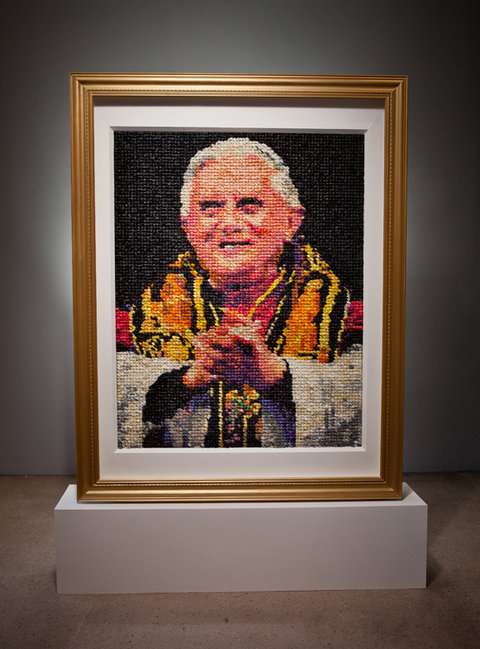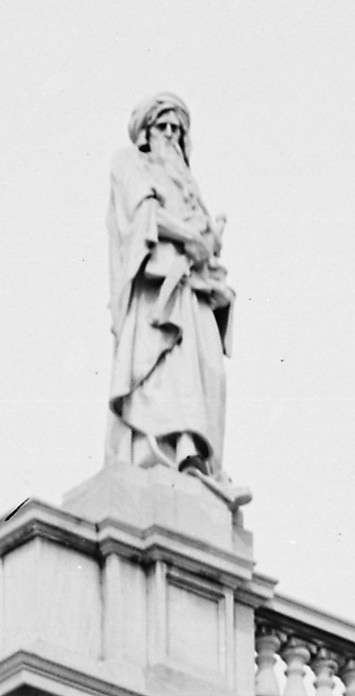New York Times: Shout Loudly Enough, and We Will Succumb to Your Heckler's Veto
Why will the Paper of Record publish a condom-Pope but not a Mohammed statue? Catholics aren't loud (or scary) enough.
In the wake of the Charlie Hebdo massacre this January, The New York Times, despite having had a good nine years to figure out how to decide whether to reprint Mohammed images that are used as justification for Islamist murder, elected predictably not to re-publish the most newsworthy cartoon of the year, and then sprinkled self-congratulation onto its self-censorship in the form of this ludicrous claim from Editor Dean Baquet:
We have a standard that is long held and that serves us well: that there is a line between gratuitous insult and satire. Most of these are gratuitous insult.
That assertion was amply disproven within hours of its utterance, and in fact was pre-disproven by The Times' own decision just days earlier to not publish file photographs of a non-satirical statue of Mohammed that stood atop a Manhatttan Appellate Division Courthouse without incident for a half-century. If the Paper of Record was being honest about its "standard," Baquet would have said "We're more worried about the angry Muslims, sorry!"
Well, the Times has now basically admitted that very sentiment, albeit with typically pompous, obfuscatory verbiage. The paper's latest display of free-speech fecklessness begins with this image, published Monday:

Yep, that's Pope Benedict XVI, made out of condoms.
After the ensuing outrage, Standards Editor Philip B. Corbett issued a remarkable statement essentially codifying the Heckler's Veto into the Times' styleguide:
There's no simple, unwavering formula we can apply in situations like this. We really don't want to gratuitously offend anyone's deeply held beliefs. That said, it's probably impossible to avoid ever offending anyone. We have to make these judgments all the time. Reasonable people might disagree about any one of them.
I don't think these situations — the Milwaukee [condom-Pope] artwork and the various Muhammad caricatures — are really equivalent. For one thing, many people might disagree, but museum officials clearly consider this Johnson piece to be a significant artwork. Also, there's no indication that the primary intent of the portrait is to offend or blaspheme (the artist and the museum both say that it is not intended to offend people but to raise a social question about the fight against AIDS). And finally, the very different reactions bear this out. Hundreds of thousands of people protested worldwide, for instance, after the Danish cartoons were published some years ago. While some people might genuinely dislike this Milwaukee work, there doesn't seem to be any comparable level of outrage.
Bolding mine, to highlight the precise terms of the capitulation.
So if you gin up a sufficient "level of outrage" (which, in the Danish cartoon example Corbett cites, includes the murder of more than 200 people), then we will prioritize your ideas about prior restraint. If, on the other hand, you are modern enough to eschew deadly rioting at the sight of contemporary or historical images demonstrating an intentional racist/collectivist animus against Jews, Japs, blacks or whoever else, then your editorial preferences are basically irrelevant. This is a perfect illustration of the Heckler's Veto, which you can read all about in the Reason archives here.

To be fair to Corbett, he wasn't specifically referring here to the decision not to reprint the file photo of the Mohammed statue. To be even more fair, any intellectually honest "standards editor" would have, since that's the paper's operational standard, high-fallutin' concerns about "significant artwork" and "primary intent" be damned. Recall the NYT's own formulation in its article about the Mohammed courthouse statue in Manhattan:
[I]n 1955 […] the statue was finally removed out of deference to Muslims, to whom depictions of the prophet are an affront.
(For the same reason, The New York Times has chosen not to publish photographs of the statue with this article.)
Because "depictions of the prophet are an affront" to Muslims, the Times reasons (inaccurately, as any trip to the U.S. Supreme Court could confirm), the paper will not even show a historical photograph of a significant artwork whose primary intent was to honor Islam's prophet. All because a minority of contemporary Muslims have sporadically used a minority of available Mohammed representations to commit murder.
Contra Corbett, this does represent a "simple, unwavering formula," just not one that reflects well on the news judgment and editorial spine of the nation's allegedly premier newspaper. The deal goes like this: If you drive the death count high enough, the paper will capitulate to your publishing demands.
Such cowardice, if widespread enough, threatens us all, particularly those who live the most bravely. As I wrote on the awful day of January 7,
If more of us were brave, and refused to yield to the bomber's veto, and maybe reacted to these eternally recurring moments not by, say, deleting all your previously published Muhammad images, as the Associated Press is reportedly doing today, but rather by routinely posting newsworthy images in service both to readers and the commitment to a diverse and diffuse marketplace of speech, then just maybe Charlie Hebdo wouldn't have stuck out so much like a sore thumb. It's harder, and ultimately less rewarding to the fanatical mind, to hit a thousand small targets than one large one.


Show Comments (105)